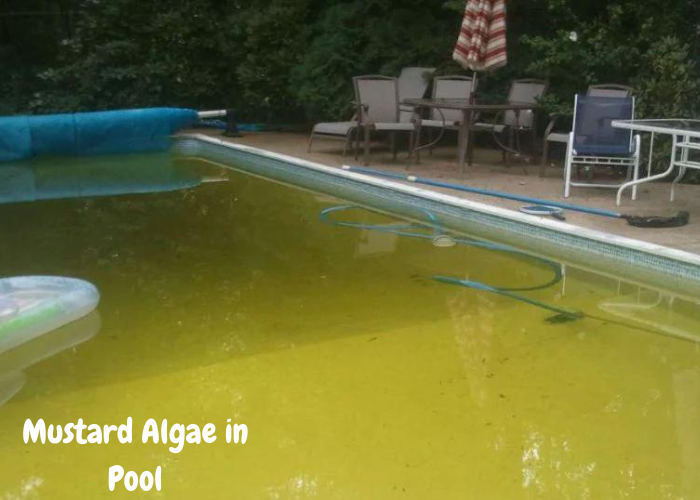Mustard algae, also known as yellow algae, is a common problem that pool owners may encounter. Despite its name, mustard algae is not actually a plant, but a form of bacteria called a diatom. It usually appears as yellow or mustard-colored patches on the walls or floor of a pool.
Mustard algae can be introduced into your pool through various means, such as contaminated pool equipment, bathing suits, or even by swimmers themselves. It thrives in warm water with improper sanitation and low chlorine levels. Once it takes hold in your pool, it can quickly spread and become a persistent nuisance.
Signs of Mustard Algae in Your Pool
Identifying mustard algae in your pool is crucial to addressing the problem promptly. Here are some signs to look out for:
- Yellow or mustard-colored patches: If you notice yellow or mustard-colored patches on the walls, floor, or other surfaces of your pool, it is likely a sign of mustard algae infestation.
- Slimy texture: Mustard algae has a slimy texture, which distinguishes it from other types of algae. If you feel a slimy film on your pool surfaces, it is a strong indication of mustard algae.
- Resistance to brushing: Unlike other types of algae that can be easily brushed away, mustard algae can be stubborn and resistant to brushing. If you find that the yellow patches remain even after vigorous brushing, it is likely to be mustard algae.
Importance of Addressing Mustard Algae Promptly
Dealing with mustard algae promptly is essential to prevent it from spreading and causing further issues. Here are some reasons why addressing mustard algae in your pool is important:
- Aesthetics: Mustard algae can make your pool appear dirty and uninviting. By getting rid of it, you can restore the pristine and clear appearance of your pool, making it more enjoyable for you and your guests.
- Health concerns: While mustard algae is not directly harmful to humans, it can create an environment conducive to the growth of other harmful bacteria and pathogens. This can pose a risk to the health and safety of swimmers. By eliminating mustard algae, you can maintain a healthy swimming environment.
- Preventing further damage: If left untreated, mustard algae can spread and cause damage to pool surfaces, equipment, and plumbing. It can also increase the risk of other types of algae infestations. Addressing the problem promptly can help prevent these issues and save you from costly repairs in the future.
Steps to get rid of mustard algae in your pool
Now that you understand the importance of addressing mustard algae promptly, let’s explore the steps to get rid of it effectively. By following these steps, you can ensure a clean and algae-free pool:
Testing and Balancing Your Pool Water Chemistry
The first step in eliminating mustard algae is to test and balance your pool water chemistry. This involves checking the pH, chlorine levels, and alkalinity of your pool water. Mustard algae thrive in water with low chlorine levels, so it is important to ensure that your pool has adequate chlorine to kill the algae.
To increase the chlorine levels, you may need to shock your pool with a high dose of chlorine or an algaecide specifically designed to target mustard algae. Follow the instructions provided by the manufacturer and maintain the recommended chlorine levels to prevent the return of mustard algae.
Brushing and Vacuuming the Affected Areas
Once you have balanced the water chemistry, it is time to physically remove the mustard algae from your pool surfaces. Start by brushing the affected areas vigorously using a pool brush. This will help dislodge the algae from the surfaces and expose it to the chlorine.
After brushing, use a pool vacuum to remove the dislodged algae and debris from your pool. Make sure to thoroughly vacuum all areas, including the walls, floor, and corners of the pool. This will help prevent any remaining algae from regrooming.
Shocking Your Pool with the Right Chemicals
Shocking your pool with the right chemicals is an effective method to kill and eliminate mustard algae. Choose a chlorine-based shock treatment that is specifically formulated for mustard algae. Follow the instructions carefully and add the recommended amount of shock treatment to your pool.
During the shocking process, it is important to run your pool filtration system continuously to ensure proper circulation of the chemicals. This will help distribute the shock treatment evenly throughout the pool and eliminate any remaining algae.
Maintaining Proper Pool Filtration and Circulation
After treating your pool for mustard algae, it is crucial to maintain proper filtration and circulation to prevent its return. Regularly clean and backwash your pool filter to remove any trapped debris or algae. Ensure that your pool pump is functioning optimally and running for an adequate number of hours each day.
Additionally, consider using a pool clarifier or algaecide as a preventive measure to inhibit the growth of algae. Regularly monitor and adjust the chlorine levels to keep them within the recommended range. By maintaining proper pool filtration and circulation, you can minimize the risk of mustard algae reappearing.
Conclusion
Mustard algae can be a frustrating problem for pool owners, but by following the steps outlined in this guide, you can effectively get rid of it and enjoy a clean and algae-free pool. By testing and balancing your pool water chemistry, brushing and vacuuming the affected areas, shocking your pool with the right chemicals, and maintaining proper filtration and circulation, you can eliminate mustard algae and prevent its return. Enjoy the crystal-clear waters of your pool and dive into a refreshing and algae-free swimming experience!
